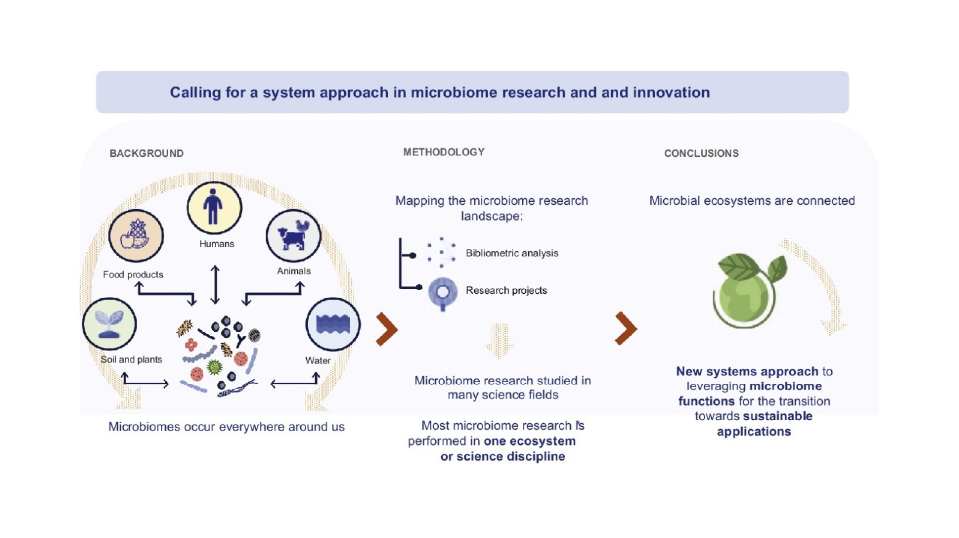You can find them in soils, plants, animals and even our own body: Microbiomes are everywhere! Because of their key role in the health of humans, animals, plants and the environment, their applications are expected to solve various societal challenges. In a recent study, researchers in the field of microbiome research, collected research projects and publications done on microbiomes. They concluded that a systems approach, in which research initiatives and their microbiomes of interest are connected, is needed to fully unlock the potential of microbiomes.
By the UNLOCK team / November 10, 2021
KEY MESSAGES
- Microbiomes can be found in all ecosystems, including humans, plants, (livestock) animals, and soil- and aquatic environments.
- Given their impact on ecosystems, they are key to new sustainable applications, such as biofertilizers and probiotic food supplements.
- Current microbiome research is fragmented and often limited to describing bacterial composition, instead of being inclusive towards other microbes and their function.
- Moreover concepts and tools across different microbiome fields are similar
- According to Meisner et al., a systems approach in which research initiatives and topics are integrated, is needed to fully unlock the potential of microbiome-based applications.
As we explained in a previous blogpost, microbiomes are more than the sum of its parts. Next to its members – micro-organisms such as bacteria, fungi and micro-eukaryotes – the term “microbiome” describes its microbial activity and interaction with the host or environment. Microbiomes are literally everywhere; in both natural and cultivated ecosystems, such as humans, plants, soils, sediments and livestock animals. This makes them key players in the development of new, sustainable applications in the bioeconomy. You could think, for instance, about biofertilizers to combat hunger; probiotic food supplements to improve gut health or the use of microbial communities for waste water treatment.
Microbiome research today
Microbiome research has been booming in the past decades and is expected to grow even further in the coming years. Recently, Meisner et al., reserachers from – amongst others – the Microbiome Support consortium critically looked at the current state of microbiome research. To this end, they collected relevant research projects related to microbiomes as well as publications till early 2020. Of the projects identified, the majority concerned human microbiomes (mainly intestinal), followed by environmental microbiomes (mainly soil). Remarkably, only less than 0.01% of the publications and 9% of the research projects identified, used a systems approach in which different ecosystems were connected. According to Meisner et al., this could be explained by the following:
- Relatively low project budgets supporting one early career scientist
- Many past projects describing microbiomes within one ecosystem
- Cecentralization of research organizations involved
- Microbiomes hardly playing a role in research strategies published before 2020.

Different fields, similar concepts
Although the knowledge on different microbiome fields is fragmented and at a different stage of development, Meisner et al. point out that each field employs similar ecological concepts. For instance, the presence of an indigenous microbiota can prevent or outcompete the colonization of potentially harmful microorganisms (“pathogens”), a concept called colonization resistance. This concept has been translated to practical applications in both soil disease and human gut health. Similarly, both soil and fecal translations are applied to strengthen the existing soil and gut microbiome, respectively. Besides concepts, microbiome fields also share tools. These tools, however, have been largely limited to measuring bacterial composition.
Beyond bacteria and composition
To obtain a more complete insight, Meisner et al. suggest to also focus on microorganisms beyond bacteria and, additionally, on their function, as well as their effect on the whole ecosystem. Moreover, it should be acknowledged that different microbiomes are interconnected. For instance, soil microbiomes influence plant microbiomes and food products with microorganisms or microbial metabolites influence the gut microbiome and in turn, its host.
Towards a systems approach in content
Based on the current state of microbiome research as a whole, Meisner et al. advocate for a systems approach. Firstly, this includes understanding how changes in microbiomes affect their composition and function as well as functioning of the whole ecosystem of which they are part of. Secondly, it entails the understanding how changes in one ecosystem affect other ecosystems. Supposedly, this will pave the way for applications in which microbiomes are manipulated on purpose, taking into account the possible consequences this has for other, connected ecosystems.
Towards a systems approach in strategy
According to the authors, a systems approach in terms of fundamental, biological concepts also requires an integrated approach in the research strategy itself. Such an approach would include the stimulation of inter- and trans-disciplinary research projects as well as education and information to raise awareness. Next, it should encourage “microbiome literacy” and appropriate regulatory frameworks for safe, but swift implementation of microbiome applications. Lastly, it should aim at an international network of stakeholders and scientists. All in all, these improvements would fully unlock the potential of microbiomes and boost microbiome-based bio-innovations.
Read more
If you want to read the full publication, including more examples of microbiome research and its applications, please check the link below.
Additionally, you can visit the website of other microbiome-oriented initiatives – all H2020 Innovation Actions:
